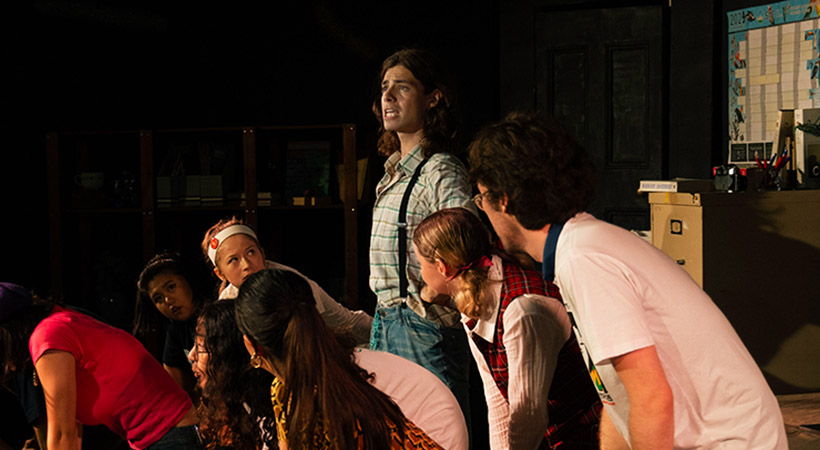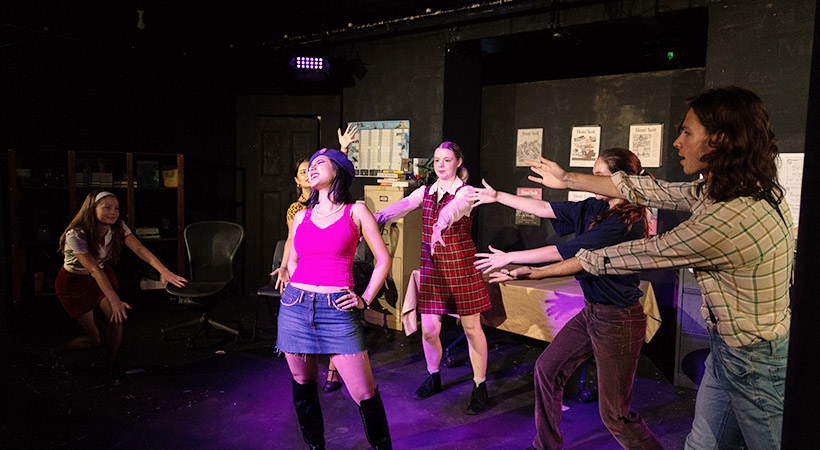If you went looking for queerness in musical theatre, you wouldn’t be looking for long.
Musical theatre has long been a safe space for queer people. Over half a century, it has increasingly represented sexuality and gender on stage and given a platform for LGBTQ performers to shine.
With queer celebs like Jonathan Groff, Jinkx Monsoon, Cynthia Erivo and Renee Rapp killing it on stages, screens, and in the studio, queer theatre is becoming increasingly visible. The popularity of queer movie musicals, such as Mean Girls and the anticipated Wicked, shows the ways theatre has evolved and become gay-er.
From one theatre-gay to another, I’ll take you through some of the big queer moments in theatre history and invite you to be a part of that history too!
How has musical theatre become a haven for queer and trans people?
Community theatre has long been a safe space and welcoming environment for queer people to express themselves creatively. There is a level of campness to every theatre production, with extravagant costumes, expressive ballads, and punchy dance numbers. Theatre and the arts, more broadly, often encourage young people who might not fit in elsewhere. Queer performer Nia Sinclair reflects that:
“In a way, being queer is creative, even if one doesn’t have to be queer to be creative. The arts is almost a safe haven for queer people.”
Watching theatre can often be the first time someone sees queer and trans characters and actors. Non-binary actor Benedict Case believes that “theatre provides the spaces where we can be seen, share our stories and in a small way, change the world.”
 Credit: Matthew Miceli
Credit: Matthew Miceli
Is there a history of queerness in musical theatre?
Queerness has always existed, so it is no surprise we can find it throughout the roots of theatre. For instance, queer themes can be seen in Shakespeare’s A Midsummer Night’s Dream, as well as the play’s performance with female characters portrayed by men in women’s clothes.
Inspired by liberation movements, the Gay Sweatshop Theatre Company emerged in the US in the 1970s to redefine mainstream depictions of queer people.
A couple of poignant musicals since the 1970s have championed queer stories and representation.
The Rocky Horror Show (1973)
First performed on the West End, this camp and comedic musical is a tribute to the science fiction and horror genres of mid-century film and television. Drawing influence from the countercultural movements of the 1960s, it was one of the first shows to depict fluid sexuality and gender. Most famously, the lead character, a mad scientist named Dr. Frank-N-Furter, is a trans and bisexual icon. The musical and its 1975 film garnered a cult following, which remains popular today, with a 2024 production in Sydney and Melbourne.
Falsettos (1981)
A personal favourite of mine, Falsettos, is a sung-through musical about queer life, Jewish identity, and gender roles in the late 1970s and 1980s. It depicts a messy and steamy gay relationship between Marvin and Whizzer and the trials and tribulations of Marvin’s family and friends. Falsettos was an early depiction of the AIDS crisis, the second act depicting Whizzer’s HIV diagnosis. The inclusion of lesbian characters Cordelia and Charlotte (who is also Whizzer’s doctor) is a tribute to the lesbians who assisted gay men during the epidemic. The 2016 Broadway revival starring the dreamy Andrew Rannells and Christian Borle brought a second life to this underappreciated musical.
RENT (1994)
Another classic, RENT, is a rock musical by the infamous Jonathan Larson, telling the story of a group of struggling young artists in New York under the shadow of the HIV/AIDS crisis. The main cast features several queer, people of colour and depicts the intersections of class, sexuality and race. It explores issues such as police brutality and how young queer and straight people alike were affected by HIV/AIDS. The first Broadway production closed in 2008 after 12 years, making RENT one of the longest-running shows on Broadway.
A Strange Loop (2019)
The main character Usher is a fat, queer, Black man who is stuck in ‘A Strange Loop’ of his doubts as he attempts to write a musical about himself. The musical portrays what it’s like being a young, queer person of colour, including going for a sexual health test, taking PrEP and using dating apps. Featuring an all-Black cast, the show critiques the whiteness of Broadway and calls for more diversity in theatre. A Strange Loop is a perfect example of queer visibility in theatre and shows us the positive direction the industry is moving in.
How to get involved in musical theatre?
Even if you aren’t the next Boy from Oz, community theatre is a fabulous way to experience the joy of musicals. Plenty of community theatre companies around Australia put on musicals throughout the year to get involved in. Even if you aren’t a performer, there are plenty of creative backstage roles, such as costuming, lighting and sound.
You can also support queer artists and performers by attending queer theatre productions. There are also several festivals throughout the year you can attend, such as the Australian Musical Theatre Festival in Launceston, the Ballarat Festival of Australian Queer Theatre and the Adelaide Cabaret Festival.
Taking part in musical theatre has given me a world of confidence and allowed me to express myself, my creativity, and my identity. Some of my happiest and most fun times were during shows! I encourage anyone, regardless of your experience, to get involved in the magic of musicals.
 Credit: Matthew Miceli
Credit: Matthew Miceli